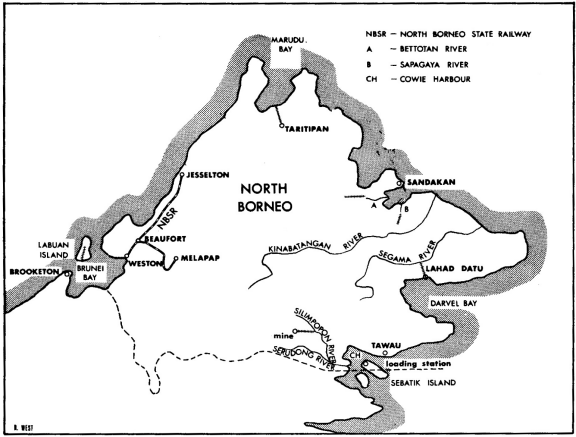
| THE INDUSTRIAL RAILWAY RECORD |
© JUNE 1967 |
INDUSTRIAL LOCOMOTIVES OVERSEAS
(5) BORNEO
A. N. M. GARRY
The lack of documentation of the industrial locomotives in North Borneo is an example of missed opportunities on my part as I was in a position to carry it out during my employment there between 1915 and 1938. Thanks to various correspondents since the war, some facts have been unearthed which are included in this article. Only in the case of the State Railway, which possessed a number of industrial type locomotives is there an official list, which I discovered many years ago. Fortunately I copied it out at the time and kept it up to date. With regard to the adjacent territories of Brunei and Sarawak I have taken the opportunity of including such details as are known to me.
Whilst I was in North Borneo the Government was in the hands of a Chartered Company, the last of its kind and modelled in a way on the old East India Company. The British North Borneo (Chartered) Company Ltd. was incorporated by Royal Charter dated 1st November 1881 to take over, from the British North Borneo Provisional Association Ltd., its absolute rights of sovereignty to the northern portion of the island of Borneo. The territory of some 29,000 square miles was granted in 1877−78 in perpetuity by the Sultans of Brunei and Sulu. Although it had powers to trade, but without any general monopoly, the Company confined itself to administration and development.
North Borneo became a Crown Colony on 15th July 1946, and on 31st August 1963 was officially renamed Sabah when granted internal self-government. On 16th September 1963 it assumed its present status as an independent state of the Federation of Malaysia.
The following concerns are known to have used industrial locomotives.
NORTH BORNEO
THE BRITISH BORNEO EXPLORATION SYNDICATE COMPANY LIMITED
This Company, floated in 1904, acquired a monopoly over the mineral rights in the Territory and attempted to work a manganese deposit in Marudu Bay at the north end of the island. It constructed a wharf and offices, with a metre gauge railway about 22 miles long leading to the workings. Owing to inefficient supervision, the first and only shipment consisted mostly of shale covered with a layer of manganese and the whole lot was dumped into the sea on arrival in England, resulting in a financial loss from which the Company never really recovered. The line was taken up and eventually became an earth road to Taritipan Rubber Estate to whom the land including the deposit (never worked again) was sold; it made a pleasant shady walk for visitors to the Estate. In 1913 the Company was induced to surrender its monopoly, having, in the words of the late Mr Owen Butter, "accomplished little but the blasting of innumerable expectations." Its two 0−4−2 side tank locomotives, BILIAJONG (Kerr Stuart 767 of 1905) of the "Waterloo" type and MARUDU (built by Dick Kerr in 1905) were acquired by the State Railway, also of metre gauge, keeping their old (local) names. BILIAJONG was scrapped prior to 1914 and no photo is known of it; it had 9½in by 15in cylinders. MARUDU on the other hand worked local suburban trains from Jesselton (the sea terminus of the State Railway) for many years. It survived two world wars, including the Japanese occupation, and, except for an extended smokebox fitted in 1927, remained in its original condition (9in by 16in cylinders and 2ft 6in wheels) until scrapped in 1954. It was always a reliable and popular veteran. I have one of its plates which is inscribed "Dick Kerr & Co. Limited, Engineers and Contractors, London and Kilmarnock, 1905," but bearing no number.

For reasons of clarity it has been necessary to exaggerate the length of certain industrial railways on this map, and space considerations preclude showing the Sadong Colliery and the Sarawak Government Railway.
BRITISH BORNEO TIMBER COMPANY LIMITED
This concern dates from 23rd January 1920 when it acquired the China-Borneo Company Ltd., of Hong Kong. Five days later it acquired a concession from the British North Borneo Company conferring on it the exclusive right to cut timber for export on any "State Lands" forming part of the British North Borneo Company's territory. Prior to 1932 it was the only one of the Borneo timber companies to use locomotives for conveying timber from the logging sites to riverside wharves. From here it was rafted to the port of Sandakan for shipment all over the world, including the United Kingdom, where it was used, among other things, for the panelling of London, Midland & Scottish Railway carriages and for the deck planking of ocean liners and warships.
The Sapagaya River Camp had one locomotive, an 0−4−0 side tank of German origin, possibly built by Orenstein & Koppel. A distinct overhang at the rear rendered it very unsteady and it frequently became derailed. To ride in its narrow cab was an experience which one did not wish to undergo too often, even though the only other way of visiting the workings was to walk along the track in the steaming heat of the jungle. The line was about two to three miles long, and I think the gauge was about 2ft.
Bettotan River Camp, the largest one managed by the Company, had two locomotives, TAIKOO, an old 0−4−2 side tank with outside motion and Salter safety valves (from its name, possibly from Hong Kong), and No.1. a Shay geared locomotive (0−6−0 + 0−4−0) built by the Lima Locomotive Company, which seemed to do all the work. The "main line" was three or four miles long, extended as necessary, with temporary spurs thrown off as required on each side of it.. Europeans visiting the workings travelled on the small platform in front of the smokebox, with their legs hanging over the buffer beam, a step being provided to get up to it. This was all right going up, but coming back tender first was less comfortable, for spark arresters do not eliminate acrid wood smoke. Unfortunately I did not measure the track gauge but I recall it as being about 2ft. I did not visit the camps again after 1926 and have no record of any further locomotives. The name of the Company was changed on 7th October 1963 to the Sabah Timber Co. Ltd.
THE BRITISH NORTH BORNEO STATE RAILWAY
Although not strictly within the scope of this article, this metre gauge line possessed the following industrial-type locomotives, besides BILIAJONG and MARUDU already mentioned.
PROGRESS and ENTERPRISE
These were 0−4−2 side tanks with domeless boilers and raised fireboxes, Alexander Penney Nos. 1009 of 1897 and 1011 of 1898. The latter number is ascribed in the official list to ADVANCE, a 4−4−0 built in 1900. As however A.P. 1010 is said to have been an 0−6−0 side- (or saddle) tank supplied to Egypt, it is reasonable to suppose that 1011 is correct and that ADVANCE was in fact A.P. 1012. Alexander Penney & Company appears to have been a London firm of agents dealing mainly with Brush (and Falcon). Certainly, an A.P. plate in my possession came from a 4−6−0 with distinctly Brush characteristics. As it is A.P. 1016 of 1904, the firm's dealings in locomotives do not seem to have been very numerous. Both PROGRESS and ENTERPRISE were used by Pauling & Co. Ltd. in the construction of the main line from Jesselton to Beaufort (57 miles and were taken over by the State railway on completion in 1902. ENTERPRISE was scrapped before 1914, but PROGRESS survived on shunting duties, mainly between Jesselton Station and the wharf, until 1922. It was sometimes left for the night, rather unwisely, in front of the Hotel, where it formed an irresistible attraction to revellers, culminating in its derailment one night, with considerable damage. It says much for its solid construction that it survived this vandalism, being sold to a timber firm in the Philippines in 1922.
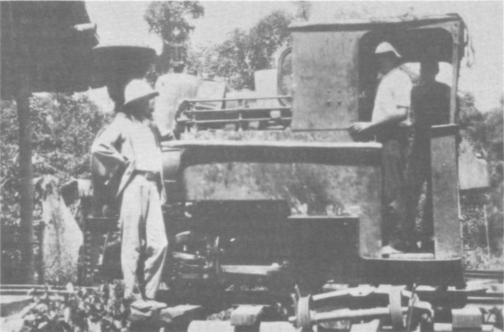
The unidentified German locomotive at the Sapagaya River Camp of the British Borneo Timber Co. Ltd., in 1925. (Author)

MARUDU, formerly owned by the British Borneo Exploration Co. Ltd., shunting at Jesselton on the State Railway about 1920. (Author)
EDWARD DENT
Usually known as DENT, this locomotive was a Kerr Stuart "Waterloo" 0−4−2 side tank, No. 765 of 1902, and sister to BILIAJONG mentioned earlier. It was stored prior to 1914, but was fitted with an extended smokebox and returned to service in 1920. A few years later, it was sold to the Woodford Rubber Estate, near Beaufort, as a stationary boiler.
Sentinel locomotive
Makers' number 6375 of November 1926, this was a four-wheeled geared locomotive with a vertical boiler. It was delivered in 1927 and tried as a relief to MARUDU on suburban trains, but its insufficient power and pyrotechnical displays at night, which led to a number of claims from ladies for spoilt dresses, resulted in its being fitted with a superheated boiler in 1929, its wheelbase also being lengthened. Like a11 locomotives on the railway, it was a wood burner. It remained in service as a yard shunter until 1963, and was finally withdrawn in 1964.
10 CELINE, 11 .ELISA, 12 EMMA
10 and 11 were built by the American Locomotive Company (Cooke Works in 1915, works Nos. 55241 and 55240 respectively, as part of an order for twenty 0−6−0 tram engines for the Societe Nationale des Chemins de Fer Vicinaux (Belgian local railways), S.N.C.V. Nos.1001 - 1020. 12 was built by Haine St. Pierre in 1919, works No. 1289, for the Grand Pont sugar factory at Hougaerde. All three were 0−6−0 side tanks, and were acquired by the State Railway from either a Belgian colliery or Antwerp Docks through the Crown Agents in 1949 to overcome the shortage of motive power due to wartime damage; they retained their original names. All had overall canopies, but these were removed from CELINE and ELISA and replaced by cabs. EMMA was a complete failure owing to a defective firebox; it would not steam properly and was condemned in 1951, being sold for scrap in 1954. The other two worked satisfactorily on shunting and ballast duties until 1959 when they too were scrapped. Rather unkindly, a photograph of CELINE as a typical Borneo Railway locomotive appeared in a highly inaccurate and misinformed article on the railway in a well known British newspaper in 1955, the writer, apparently a woman, never having consulted the Chief Mechanical Engineer to verify her statements. EMMA, one of whose plates I possess, had 2ft 8½in wheels and 11in by 14in cylinders; the other two had 3ft wheels and 11in by 15¾in cylinders (originally 2ft 10in and 11½in by 16in). The State Railway, once 124 miles long but since reduced to about 100 miles by elimination of its branches, served a number of rubber estates of which several had their own private sidings or short branches connecting with it. Up to 1946 at any rate, none of them employed any motive power other than the human variety, nor were the State Railway's locomotives allowed to run on them.
COWIE HARBOUR COAL COMPANY LIMITED
This concern was formed on 15th November 1905 to acquire prospecting rights over 900 square miles of territory and with the right to hold a lease for 99 years of 24 square miles therein. It worked the Silimpopon Coal Mine on the Silimpopon River close to the Dutch (now Indonesian) border, for which purpose it built a 2ft gauge line about five or six miles long to carry coal to "Number Two Loading Station" on the Silimpopon River. Here the coal was transferred by a chute into barges which were towed by steam launch for about two hours either to a loading station on Sebatik Island, accessible to ocean-going steamers (for cargo or bunkers), or else to await a coasting steamer to tow them from Sebatik for another three days (or more, depending on the tides and the capabilities of the steamer), to Sandakan, the principal port of the Territory, which also had coaling facilities. The mine itself was literally a clearing in the virgin jungle, complete with offices, coolie lines, bungalows, repair shops, pumping and compressor stations, and was worked on the adit system. The gradient was in favour of loaded trains and at one point, near the Hospital, was quite severe.
Europeans, both visitors and staff, notified their impending arrival by carrier pigeon from the Government Station and port of Tawau - two hours by launch in the seaward direction from Sebatik - and a "push trolley" with four men was sent to "Number Two" to meet them. On arrival there, one went to the office to enquire by telephone to the camp if a train was on the way, and if so, when it had left. If, as happened frequently, the telephone was out of order owing to the depredations of wild elephants or white ants against the telephone poles, one set off carefully, stopping before each curve to listen for the engine whistle which the driver was supposed (but often forgot) to blow, or to look for the dense clouds of smoke against the distant jungle. In either event one was prepared to jump off and remove the trolley from the line in double-quick time; Strange to say, I remember only one fatal accident, when two ship's officers set off against all advice; they met the train in a cutting and one was killed. In at least fifty trips up and down the line I only once met an engine head on. This was close to "Number Two" on the return journey, when thoughts were centred on a cool drink on the launch in a few minutes' time and attention was relaxed. Fortunately, the train was still travelling slowly and, although the trolley was a "write off", the passengers' luggage was only slightly dented; On other occasions I travelled with the train, the trolley being attached by a rope to the coupling of the last truck. I had to make sure the head "trolley boy" kept awake and took in the slack before each curve so as to prevent the trolley taking a short cut across it.
Tawau, now an outpost against Indonesian terrorism, was in those days peaceful except for an occasional outbreak of racial trouble between the various races of Chinese at the mine. It was also a strange mixture of ancient and modern as it had a local telephone, but no electric light, no "mod. cons.", no tarmac roads and only one taxi - a temperamental Ford "Model ". But it had a radio station, put up by Telefunken of Germany in 1913.
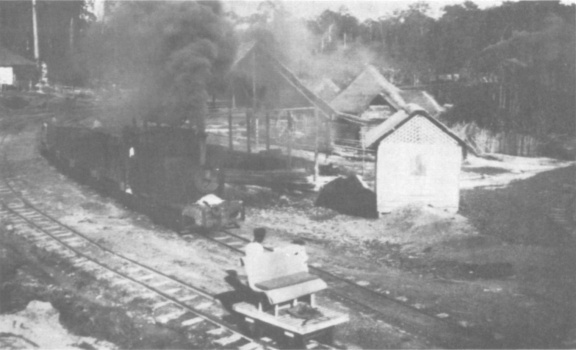
No.3 of the Cowie Harbour Coal Co. Ltd., at the "Number Two Loading Station" in 1925. Note the passenger trolley in the foreground with cushion for Mrs. Garry. (Author)

No.3 of the Cowie
Harbour Coal Co. Ltd.
(Official photograph from the collection of R. T. Russell)
The pigeon post to the mine may sound primitive but it was most efficient, although each message had to be sent in duplicate (two pigeons) owing to the fairly high mortality rate from hawks, sea eagles and other predatory birds. It was a two way service, the cost being shared by the Coal Company and the Government, and it was part of my duties to pay periodical visits to the Malay "bird man" and to inspect his charges. The whole thing needed some organization as the birds tended to forgot their home station after about two weeks, and if there were no messages in view they had to be sent home by launch. It was too expensive to risk flying them home "light engine" for the reasons I have mentioned;
The Company owned four locomotives, and Mr Russell has kindly supplied the following details. By a process of elimination No.1 was almost certainly Barclay 713 of 1892, an 0−4−0 saddle tank with 2ft 5in wheels and 6in by 12in outside cylinders. It was shipped through agents to Borneo on 8th February 1892, but what it was doing before the formation of the Company in 1905 must remain a mystery. (The coal deposits, too, were only found in 1903. No.1 had the square works plate of the period, and the only photograph I know of No.1 shows holes in the cab sheet that indicate such a plate. It had outside frames like No.2 and No.3, but smaller tanks.
No.2 was Barclay 1101 of 1906, an 0−4−0 saddle tank with 2ft 2in wheels and 8in by 12in outside cylinders. It was shipped from Glasgow to Borneo on 14th December 1906, and carried the painted name ANNIS YERE. The latter to me is devoid of any possible significance, linguistic or otherwise, and was removed before I saw the locomotive. No.3 was Barclay 1275 of 1912, an 0−4−0 saddle tank with 8in by 14in outside cylinders. It was identical in appearance with No.2 and was shipped to Borneo on 9th April 1912.
No.4 was Barclay 1413 of 1915, an 0−4−0 well tank with 2ft 0in wheels and 7in by 12in outside cylinders. Built originally as an experimental design, it was the prototype of many 0−4−0 well tanks although not the first to be sold as it was not shipped until 29th May 1917. It was not as steady running as the other three locomotives.
There had always been trouble with water seeping into the workings and, impregnated as it was with hydrogen sulphide, it played havoc with machinery and pipes. Wooden pipes and even wooden rails replaced metal ones in the adits, while protective overalls and rope soled canvas shoes were essential for those going down the adits. I well remember the day when they reopened a long-flooded working to pump out the water, only to release a smell of sulphurated hydrogen which permeated the camp and all the bungalows for days. Competition from oil and Japanese coal, together with the rising cost of pumping gradually made the mine uneconomical to work and it was decided to terminate the mining lease on 31st October 1931, although the Company was not liquidated until 28th July 1937.
The larger machinery, including a fine Walker engine, was left behind as the cost of dismantling and transport would have been too great. Locomotive No.1 which had been out of use for some time was also left behind but the other three were taken to "Number Two" where one, either No.2 or No.3, was for some reason abandoned. The other two were sold to the North Borneo Trading Company in Sandakan for work in logging camps, and it is doubtful if they survived the Japanese occupation. The machinery and the two abandoned locomotives have long since been swallowed up by the jungle where, perhaps, in time to come, they may be unearthed as evidence of some obscure religious cult.
LABUAN COLLIERY, LABUAN ISLAND
Labuan Colliery was opened in 1847 by the Eastern Archipelago Company which was succeeded by various companies, of which the last seems to have been the Oriental Coal Company. At its best the output was 5,000 tons a week, and trouble frequently experienced with sea water seeping into the seams that were under the sea led to its closure in 1911 and abandonment the following year. For some years the Brooketon and Labuan collieries were under the same management in which the then Rajah of Sarawak played an active part
A 2ft 5in gauge railway about eight miles long ran from Port Victoria, as the town was called, to the workings. Unfortunately, little is known of its locomotives, of which bits and pieces were still lying near to the coal wharf when I first visited Labuan in 1915. Two are said to have been named SINGA (lion) and BRUONG (bear) but the only one positively identified (thanks to Mr Russell's researches) is Barclay 816 of 1898, an 0−6−0 saddle tank with inside frames, 2ft 2in wheels, and 9in by 18in outside cylinders. Originally, it is thought, intended for South Africa, it was sent to the "Labuan & Borneo Co." in April 1898. It was painted Bismarck brown, and carried ASHLEY nameplates.
Mr J. Maxwell Hall, in his book "Labuan Story", relates a number of tales about the Colliery Managers, of whom many were tough characters and a law unto themselves. Tickets were issued to passengers who wished to travel on the line, for which purpose a shabby coach was attached to the rear of the coal trains. One Manager operated a private black list of people whom he disliked. A certain gentleman on the list, spotted one day with a ticket bought for him by a friend, was promptly challenged by the Manager to a fight to settle the point, to the great enjoyment of the other passengers!
Another Manager complained to the Resident of the disturbance caused to him and his staff by the bugle calls of Sikh soldiers from their barracks near the Company's office, efforts which he described as "discordant blasts on brazen trumpets which deafened the ears of a Christian gentleman". Receiving no response to his complaint, in due course he fitted one of his locomotives with a siren salved from a wrecked steamer (probably the s.s. ST. PANCRAS). It was then placed on the line at the back of the Residency, and the Manager arranged matters so that a full head of steam blew continuously through the siren from dinner-time until the early hours! He himself retired to his bungalow at the north end of the island, with orders that he was not to be disturbed on any account. Needless to say, he won his point!
Labuan has a splendid harbour. Both sides used it for coaling in the Russo-Japanese War, as did the Allied fleets during both World Wars. The public road following the old railway alignment was renamed "McArthur Road" after the famous U.S. General who personally commanded both the U.S. Marines and the 9th Australian Division when they landed there in June 1945 to form a base for the liberation of Borneo. Today, although its ambitions to become a coaling station have not been realised, Labuan is a much used anchorage (labu = anchor as well as being one of the important commercial airports of south-east Asia.
NEW DARVEL BAY (BORNEO) TOBACCO PLANTATIONS LIMITED
This old-established company (registered on 17th September 1892 to take over the estates of the Darvel Bay (Borneo) Tobacco Plantations Ltd., formed on 4th April 1889) was originally under Dutch management. In 1906 it decided to replace the earth road from its headquarters on the Segama River to the port of Lahad Datu on the east coast by a 60cm gauge railway some eight miles long. Its locomotives were all Kerr Stuart "Wren" class 0−4−0 saddle tanks (see RECORD 5/6) which were found to be eminently suitable. Kerr Stuart records, indicate that four of the "old type" and two of the "new type" (4021 and 4024 of 1919) were supplied, but I never remember more than four locomotives being there at any one time. With only one or two trains a day at the most - and less when the tobacco season was over - there was no call for six locomotives. No.1 and No.2 were Kerr Stuart 914 (shipped on 19th March 1907 for £400) and 1018 (shipped on 9th December 1908 for £400) respectively; No.3 was presumably 4208 (shipped on 12th July 1920 for, £1135). There was certainly one of the "new" type there by 1920 (No.4) but its Hackworth valve gear did not find any favour with the Engineer, who was inclined to be old-fashioned and who did not have the skilled staff to maintain more complicated machinery. He would certainly have opposed a second locomotive of that type seeing that No.4 was rarely used. I would think therefore that No.4 was one of Kerr Stuart 4021 or 4024, the other being sent elsewhere.* A fourth "old type", Kerr Stuart 4387 (shipped on 2nd July 1926), was probably a replacement for one of the first two locomotives which, with the rather primitive arrangements for maintenance, may well have been worn out by then. It may even have been a replacement for No.4 itself.
Tobacco was carried across the river by a wire-rope ferry, and thence by trains of three or more double bogie wagons with corrugated iron roofs and open sides to Lahad Datu "station" on top of the bill above the town. Here the engine was detached and the trucks run by gravity down quite a steep gradient on to the jetty. The temptation to travel at speed down the hill, although strictly forbidden, sometimes proved too much for the native brakesmen (one to each truck) and on at least one occasion the tardy application of the brake resulted in the truck running off the wharf into the harbour, the brakesmen having baled out when they saw what was going to happen. Trucks that were empty or loaded with stores had, of course, to be pushed up the hill. Trains ran as required, but always in connection with the fortnightly steamer to or from Sandakan. Europeans were provided with comfortable cane chairs from the station office, on which they travelled quite pleasantly in the last truck. Colonial hospitality saw to it that suitable liquid refreshment was available for the journey or fifty to sixty minutes.
There were in 1925 the scanty remains of another locomotive in a shed near the river. It looked to be of German origin and was probably an 0−4−2 side tank, but nothing was known about it, save that it was thought to have been used on a line that reputedly ran in the old days from the river end of the earth road to the packing and fermenting sheds which were then on the same side of the river. When everything was moved across the river, it must have become redundant and forgotten.
The properties owned totalled 24,242 acres in 1930 when the Company was taken over by the Darvel Bay Syndicate. This was dissolved three years later, but in 1935 the tobacco plantations were reopened by Darvel Tobacco Plantations Ltd., a subsidiary of the Imperial Tobacco Co. Ltd., who state that the railway was not operating then and that the Estate records were lost during the Japanese occupation. Certainly by 1937, when I last visited the plantations after an interval of twelve years, a tarmac road had been constructed, partly on the alignment of the railway, and partly on the original and more direct earth road. Darvel Tobacco Plantations Ltd. ceased its North Borneo operations in 1961.
BRUNEI
BROOKETON COLLIERY
Brooketon (sometimes known as Brookton) Colliery was an ambitious enterprise on the part of the second Rajah, Sir Charles Brooke. It owned a 2ft 4in gauge railway about a mile in length which closed in 1924. At one time it was thought that Brooketon might become a prosperous coaling port to rival Labuan, but this never came to pass because the anchorage was too exposed. Mr R. T. Russell has kindly supplied the following information concerning the two Barclay 0−4−0 side tanks that are known to have worked here, although there may have been other locomotives as well.
Barclay 696 of 1891 had inside frames, 1ft 10in wheels, 7in by 14in outside cylinders, and was only 5ft 9in high in order to clear a low (6ft high tunnel. It had the square Barclay worksplates of the period and painted on the tank sides was the name MARGUERITE REINE. (The second Rajah's wife, Margaret de Windt, was of French origin.
Barclay 815 of 1897, named BROOKETON, was an exact duplicate of Barclay 696. It was shipped from Glasgow in January 1898.

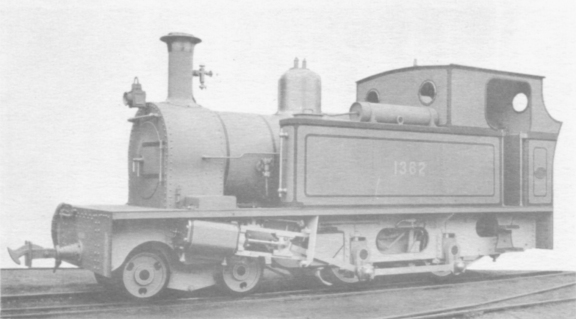
These two official photographs of Peckett 1362 taken at Bristol before shipment to the Sarawak Government Railway are of especial interest, showing as they do the nameplate fitted to one side only for photographic purposes.
SARAWAK
SADONG COLLIERY
This colliery was about fifty miles east-south-east of Kuching (the capital) as the crow flies but considerably further by river as one had to go down the Kuching River, then out to sea eastward a bit, and finally up the Sadong River for some distance. A railway (gauge not known) ran for about three or four miles from a wharf on the Sadong River to the colliery. Its operation was conducted on unconventional lines which would shock hide-bound officials in Britain, but it nevertheless served its purpose well. There were two locomotives originally, named SAMPSON and SADONG, but one of them blew up, severely injuring the driver, and was replaced by another named SKIPALONG; further details are not known. Opened about 1874, the colliery was closed during the depression of the mid-1930's. Its coal was used locally and some was exported to Singapore.
(We have been able to identify these three locomotives. They were 0−4−0 saddle tanks by Hunslet - SAMSON (note spelling: 634 of 1895), SARONG (672 of 1898) and SKIMALONG (note spelling: 952 of 1907) - for Bowes, Scott & Western Ltd. 952 is recorded as shipped to the Straits Settlements which could have been Sarawak, the destination of 634 and 672.
The gauge of the first two was 2ft 9in, SKIMALONG being 2ft 8½in. Hunslet also supplied to the same purchaser in Sarawak a 2ft 4in gauge 0−4−0 saddle tank named MOARA (772 of 1902), and an un−named 0−6−0 side tank (806 of 1903) which was subsequently converted in Sarawak to 2ft 9in gauge. Spares were sent in February 1927 to the "Sarawak Government (for Sadong Collieries)" for 672, 806 and 952, and from this it would appear that SAMSON was the locomotive which blew up. - Hon. Eds.)
SARAWAK GOVERNMENT RAILWAY
Although not strictly within the scope of this article, readers may be interested in a few details of this metre gauge railway which started off as a passenger line but seems to have finished up as an industrial one! Track-laying began in 1911 with a "light locomotive" quaintly named IDIOT, and although twenty-seven miles were surveyed only ten were built. Three Peckett locomotives arrived later - a small 0−4−0 side tank, JEAN, and two 10−ton 4−4−0 side tanks, BULAN (moon) and BINTANG (star). (These Peckett locomotives were, respectively, 1284 of 1912, 1362 of 1914, and 1363 of 1914. The former had in fact worked as a aft gauge locomotive at John Lysaght's steelworks at Scunthorpe, Lines., from June 1912 to March 1913; it was regauged by Peckett and resold in September 1913 to the Bristol Wagon & Carriage Works Co. Ltd. for The Borneo Co. Ltd. - Hon. Eds.) The official opening took place on 1st August 1915 but by January 1931, when the third Rajah ordered its general closure, the Railway had lost no less than 1,063,760 dollars (at 2s 4d to the dollar). It was used on and off (the Japanese took it over during the Second World War) for hauling stone from the quarry at Mile 10. Diesel locomotives were employed latterly, and the final closure came in 1947. What was left of the line was sold for scrap in Singapore in 1959. The passenger rolling stock (1st and 2nd class with wooden seats) came second-hand from Burma, and the goods wagons second-hand from the Federated Malay States Railway.
There is a story (probably apocryphal) told about the second Rajah, who evolved the scheme, that when in England on leave in 1907 he approached the Board of the Great Western Railway for advice. However, when the Chief Engineer heard that the narrow gauge railway was to be only ten miles long initially, he suggested that the Rajah would be better off going to Gamages!
Acknowledgements
Thanks are due to Mr G. S. Moore for builders' information on 10, 11 and 12 of the British North Borneo State Railway, and to Mr R. T. Russell for much detail on the Barclay industrial locomotives mentioned in this article.
* * *
(As a postscript to Mr Garry's graphic account of North Borneo then, we are pleased to be able 'to give some information on the position in Sabah now. For the photographs and the bulk of the information we are indebted to Mr. E.R. Neale of Ruston & Hornsby Ltd. - Hon. Eds.)
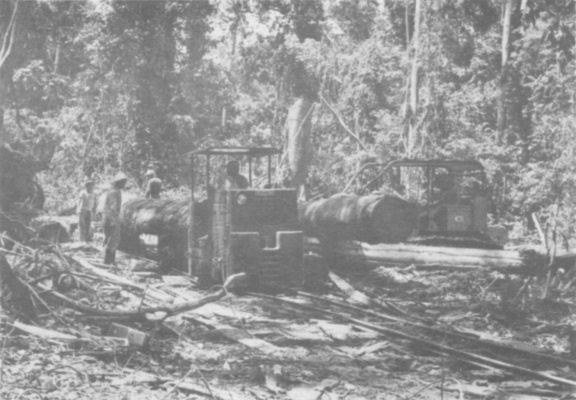
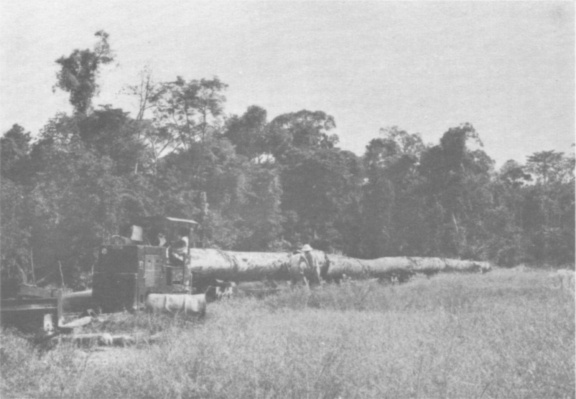
In the forests of Sabah tractor logging to rail or road is the usual method of extraction, but two of the large companies use high lead and sky-line cable systems in hilly and difficult terrain. Apart from small scale operators hand logging to rail is only practised in the ramin swamp forests on the west coast. The top quality, medium hardwood trees growing along the banks of the Kinabatangan, Labuk and Segama rivers were comparatively easy to manhandle into the water once they had been crosscut to length, but as the cutting line spread further back from the river the manual process became too slow and crawler tractors were introduced in 1954. In large concessions roads were built and the heavy logs trucked to the river for rafting. Other owners, looking at the limits of their concessions, the cost of road building, and having studied the capital and operating costs, decided on narrow gauge rail haulage with the track laid on a temporary basis and relocated as the timber was cleared.
Conditions for any mechanical equipment were far from ideal. These tropical rain forests have ambient temperatures of 120 degrees F and 95% humidity. Torrential rain storms alternate with intense dust clouds and track-laying conditions are atrocious. The air-cooled Ruston diesel was viewed with considerable suspicion, but a few months after the first locomotive had arrived its owner was so impressed with its performance that he ordered a second one.
The locomotives in use are 2ft gauge examples of Ruston class LBT, built basically to the standard 4½ton weight arrangement with the addition of a single roof canopy and electric lighting equipment. At present over thirty of this type are in use on logging work in Sabah.
* As mentioned by Mr Horsman in RECORD 5/6, page 96, Kerr Stuart Nos. 4013 - 4024 were ordered by the Ministry of Munitions. Scattered references in the builder's records indicate that these locomotives were intended for "Aerodromes", and that 4013 - 4015 and 4016 - 4019 were originally ordered as 4018 - 4020 and 4021 - 4024 respectively. 4013 - 4015 appear to have been delivered to the "Northern Aircraft Repair Depot, Greenhill, Sheffield" and 4016 - 4019 to the "Scottish Aircraft Repair Depot, Renfrew". The destinations and dates ex−works for the final batch were:- 4020 - 4022 (Leeds, 14th June 1919 , 4023 (Haverton Hill, 24th June 1919), and 4024 (Darvel Bay, 30th July 1919. Absence of specific destination details does not necessarily infer non-delivery, but perhaps some reader can suggest just where in "Leeds" and "Haverton Hill" these "Wrens" may have gone? All in this batch were built to 2ft 0in gauge except 4024 (60cm), but the Kerr Stuart ledger entries for 4021 have been amended (in red ink) to show that it was converted to 60cm gauge and shipped to Darvel Bay on 30th July 1919. It is perhaps pertinent to add that 4020, 4022 and 4023 have been noted subsequently in England, but of 4021 and 4024 there is no further record. - Hon. Eds.